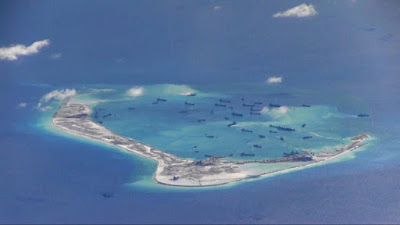Territorial disputes in the South China Sea involve both island and maritime claims among several sovereign states within the region, namely Brunei, the People's Republic of China, Taiwan, Malaysia, the Philippines, and Vietnam. There are disputes concerning both the Spratly and the Paracel islands, as well as maritime boundaries in the Gulf of Tonkin and elsewhere. There is a further dispute in the waters near the Indonesian Natuna Islands. The interests of different nations include acquiring fishing areas around the two archipelagos; the potential exploitation of suspected crude oil and natural gas under the waters of various parts of the South China Sea; and the strategic control of important shipping lanes.
Shangri-La Dialogue serves as the "Track One" exchange forum on the security issues surrounding Asia-Pacific region including Territorial disputes in the South China Sea. Council for Security Cooperation in the Asia Pacific is the "Track Two" dialogue on security issues of Asia-Pacific.
In February 2016, President Obama initiated the "U.S.-ASEAN Summit" at Sunnylands for closer engagement with ASEAN, The territorial disputes in the South China Sea was a major topic, but its joint statement, the "Sunnylands Declaration" did not name the South China Sea, instead calling for "respect of each nation's sovereignty and for international law". Analysts believe it indicate divides in the grouping on the approach in responding to China's maritime strategy.
The area may be rich in oil and natural gas deposits; however, the estimates are highly varied. The Ministry of Geological Resources and Mining of the People's Republic of China estimate that the South China Sea may contain 17.7 billion tons of crude oil (compared to Kuwait with 13 billion tons). In the years following the announcement by the ministry, the claims regarding the South China Sea islands intensified. However, other sources claim that the proven reserve of oil in the South China Sea may only be 7.5 billion barrels, or about 1.1 billion tons. According to the US Energy Information Administration (EIA)'s profile of the South China Sea region, a US Geological Survey estimate puts the region's discovered and undiscovered oil reserves at 11 billion barrels, as opposed to a Chinese figure of 125 billion barrels. The same EIA report also points to the wide variety of natural gas resource estimations, ranging from 190 trillion cubic feet to 500 trillion cubic feet, likely located
in the contested Reed Bank".
The Philippines began exploring the areas west of Palawan for oil in 1970. Exploration in the area began in Reed Bank/Tablemount. in 1976, gas was discovered following the drilling of a well. However, China's complaints halted the exploration. On 27 March 1984, the first Philippine oil company discovered an oil field off Palawan, which is an island province bordering the South China Sea and the Sulu Sea. These oil fields supply 15% of annual oil consumption in the Philippines. The nine-dotted line was originally an "eleven-dotted-line," first indicated by the then Kuomintang government of the Republic of China in 1947, for its claims to the South China Sea. After, the Communist Party of China took over mainland China and formed the People's Republic of China in 1949. The line was adopted and revised to nine as endorsed by Zhou Enlai.
Vietnam and Japan reached an agreement early in 1978 on the development of oil in the South China Sea. As of 2012, Vietnam had concluded some 60 oil and gas exploration and production contracts with various foreign companies. In 1986, the "White Tiger" oil field in the South China Sea came into operation, producing over 2,000 tons of crude oil per year, followed by the "The Bear" and "Dragon" oil fields. As of 2011, Vietnam was the sixth-largest oil producer in the Asia-Pacific region although the country is now a net oil importer; in 2009 while petroleum accounted for 14 percent of government income, this was down from 24 percent in 2004.
The position of China on its maritime claims based on UNCLOS and history has been ambiguous, particularly with the nine dash line map. For example, in its notes verbales in 2011, the first phrase stated that China has undisputed sovereignty over the islands and the adjacent waters, suggesting China is claiming sovereignty over its territorial waters, a position consistent with UNCLOS. However, the second phrase in its notes verbales stated that China enjoys sovereign rights and jurisdiction over the relevant waters along with the seabed and subsoil contained in this region, suggesting that China is claiming sovereignty over all of the maritime space (includes all the geographic features and the waters within the nine dash line). The third phrase indicates support for basing their claims on historical basis as well. Recently in its notes verbales in 2011, China has explicitly stated that it claims the territorial waters and all of the islands in which each island has its own exclusive economic zone and continental shelf. A major problem with this claim is that it fails to distinguish between geographic features considered as "islands" or "rocks" under UNCLOS. The vast majority of international legal experts have concluded that China's claims based on historical claims is invalid. Many ambiguities arise from the notion of historical claims as a basis for claiming sovereignty and is inherently ambiguous.



















0 Comments